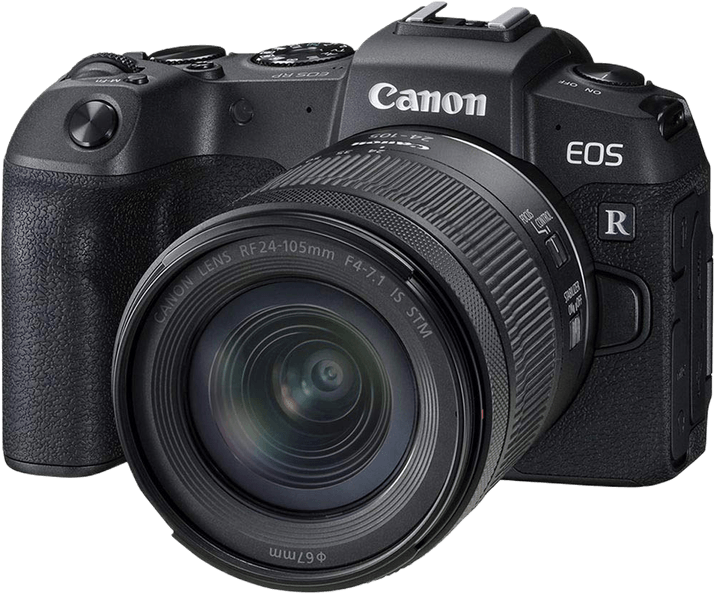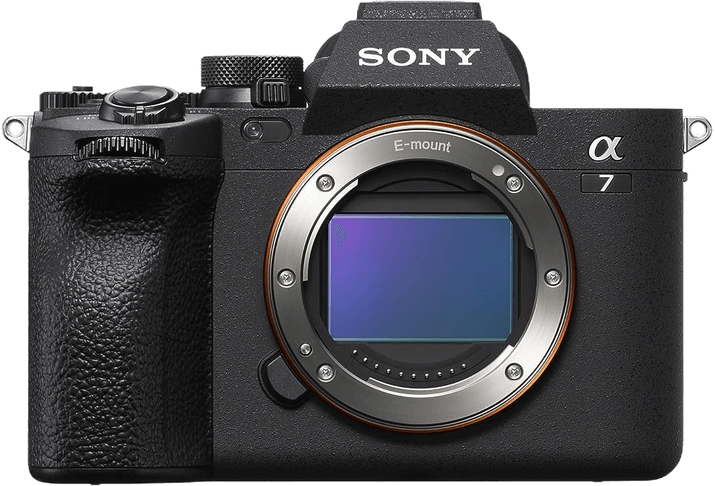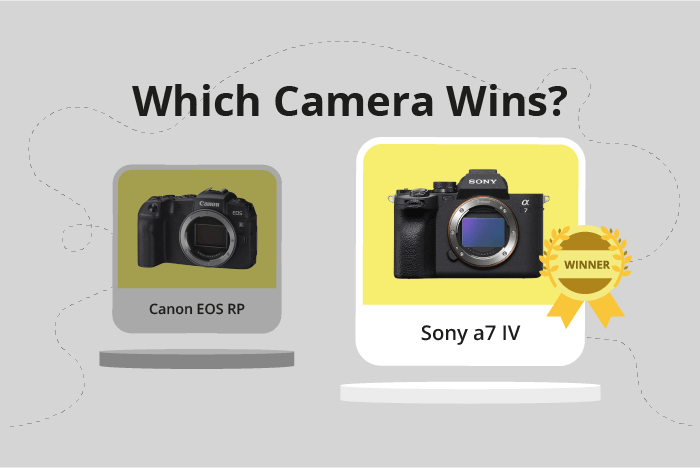Canon EOS RP vs Sony a7 IV Comparison
Canon EOS RP

Sony a7 IV

The Sony a7 IV outperforms the Canon EOS RP with a score of 84/100, compared to the Canon’s 65/100. Both cameras share common features, such as being mirrorless and having similar dimensions. However, the Sony a7 IV, released in 2021, is a more recent model than the 2019 Canon EOS RP, which could explain its higher score.
The Sony a7 IV excels with its higher resolution, better autofocus system, and improved video capabilities, justifying its higher launch price of $2499. On the other hand, the Canon EOS RP has a lower launch price of $1300, making it a more budget-friendly option. It also has a lighter weight at 440g, compared to the Sony’s 659g, which may appeal to those looking for a more portable camera.
While the Sony a7 IV is the better camera in terms of performance and features, the Canon EOS RP offers a more affordable and lighter option for those on a budget or prioritizing portability.
Canon EOS RP vs Sony a7 IV Overview and Optics
The Sony a7 IV outperforms the Canon EOS RP in optics, scoring 85 out of 100 compared to the Canon’s 67. Both cameras share similar specifications, such as CMOS sensor type, full-frame sensor size, and respective lens mounts (Canon RF for the EOS RP and Sony FE for the a7 IV).
The Sony a7 IV excels with a higher megapixel count of 33, double the shooting speed at 10 frames per second, and a superior DXOMARK sensor score of 97. Additionally, the a7 IV features image stabilization, which the Canon EOS RP lacks. The Bionz XR processor in the Sony a7 IV also contributes to its better performance in optics.
On the other hand, the Canon EOS RP has a lower megapixel count at 26 and a slower shooting speed of 5 frames per second. Its Digic 8 processor and DXOMARK sensor score of 85 are inferior to the Sony a7 IV. The absence of image stabilization in the EOS RP further highlights its disadvantage in the optics comparison.
Despite the lower score, the Canon EOS RP still offers a respectable performance in optics. Its full-frame sensor and Canon RF lens mount provide good image quality and compatibility with a range of Canon lenses. However, the Sony a7 IV clearly surpasses the EOS RP in terms of optics specifications and overall performance.
Considering the significant difference in optics scores and the advantages offered by the Sony a7 IV, it is evident that the a7 IV is the superior choice for photographers seeking better performance in optics. While the Canon EOS RP remains a viable option, the Sony a7 IV outshines it in this comparison.
Canon EOS RP vs Sony a7 IV Video Performance
The Sony a7 IV outperforms the Canon EOS RP in video capabilities with a score of 91/100, while the Canon EOS RP has a score of 70/100. Both cameras share certain features, such as the maximum video resolution of 4K and dimensions of 3840 x 2160. Additionally, both cameras have built-in time-lapse functionality.
The Sony a7 IV excels due to its higher maximum video frame rate of 120fps, compared to the Canon EOS RP’s 25fps. This difference allows the Sony a7 IV users to capture smoother, more detailed slow-motion footage, making it a better choice for videographers who require this feature.
On the other hand, the Canon EOS RP does not possess an advantage in video capabilities over the Sony a7 IV. Both cameras share the same max video resolution and dimensions, and time-lapse functionality. The only significant difference in their video capabilities lies in the frame rate, where the Sony a7 IV holds a clear advantage.
Taking into account the video capabilities of both cameras, the Sony a7 IV emerges as the superior choice for videographers due to its higher maximum video frame rate. The Canon EOS RP, while offering similar video resolution and dimensions, falls short in providing the same level of performance in video capture. Those interested in capturing high-quality video should consider the Sony a7 IV for its superior frame rate capabilities.
Canon EOS RP vs Sony a7 IV Features and Benefits
The Sony a7 IV triumphs over the Canon EOS RP in the features department with a score of 83/100, compared to the Canon’s 70/100. Both cameras share several specifications, including a 3-inch screen size, 1040000-dot screen resolution, touchscreen capability, flip screen, and the absence of GPS. Additionally, both cameras come equipped with WIFI and Bluetooth connectivity.
The Sony a7 IV outshines the Canon EOS RP in several aspects. It offers a higher feature score, indicating a more comprehensive set of functionalities that cater to a wider range of photographers’ needs. This advantage makes the Sony a7 IV a more versatile option for different photography styles and preferences. The higher score also suggests that the Sony a7 IV has a better overall performance in terms of features, making it a more reliable choice for professionals and enthusiasts alike.
While the Canon EOS RP falls short in comparison to the Sony a7 IV, it still offers a decent set of features that can cater to the needs of some photographers. The shared specifications between the two cameras ensure that the Canon EOS RP remains a competent option for certain situations. However, its lower feature score means that it may not be the best choice for photographers seeking a more advanced and versatile camera.
To conclude, the Sony a7 IV stands out as the superior camera in terms of features when compared to the Canon EOS RP. Its higher feature score and shared specifications with the Canon EOS RP make it a more versatile and reliable option for a wider range of photographers. While the Canon EOS RP may still be a viable choice for some, the Sony a7 IV offers a more comprehensive set of features, making it the better camera in this comparison.
Canon EOS RP vs Sony a7 IV Storage and Battery
The Sony a7 IV outperforms the Canon EOS RP in storage and battery, with a score of 76/100 compared to the Canon’s 29/100. Both cameras accept UHS-II compatible SD cards and offer USB charging. However, the Sony a7 IV excels with two memory card slots, accommodating CFexpress Type A and SD cards, while the Canon EOS RP has only one slot for SD/SDHC/SDXC cards.
Additionally, the Sony a7 IV boasts an impressive battery life of 580 shots, using the NP-FZ100 battery type. This significantly surpasses the Canon EOS RP’s 250-shot capacity with its LP-E17 battery. The Canon EOS RP does not have any advantages in storage and battery features over the Sony a7 IV.
Considering these factors, the Sony a7 IV clearly provides better storage options and battery life for photographers, making it the superior choice in this category.
Canon EOS RP vs Sony a7 IV – Our Verdict
Are you still undecided about which camera is right for you? Have a look at these popular comparisons that feature the Canon EOS RP or the Sony a7 IV:

